This simple pizza dough gets a subtle tang from sourdough starter discard. Easy to make, it can be ready the same day with only a few minutes of hands on work. Give your homemade pizza crust the flavor it deserves!

Jump to:
Why this recipe works
- This homemade pizza dough only takes about 10 minutes of hands-on work
- Using sourdough starter discard lends its subtle tanginess to the pizza crust
- This sourdough pizza dough can also be used to make foccacia, stromboli, or calzones
Pizza Night is an event in our house.
With so many of my family members having...ahem...specific food preferences, making a pizza becomes a game of sections. No tomato sauce here, no olives there, and definitely no fresh basil over there, Pizza Night is indeed quite individualistic.
One thing we all agree on is the pizza dough. It's got to be soft, chewy, and flavorful. Me being me, it's going to be homemade pizza dough, and it's going to use sourdough starter discard that gives a subtle sourdough tang.
In other words, it's got to be Sourdough Pizza Dough.
This sourdough pizza dough recipe is not unlike my sourdough focaccia recipe. In fact, they are the same! It's just how the dough is shaped, finished, and baked that's different. And like with the focaccia, the pizza toppings are completely customizable to your tastes. Use your favorites!
Recipe Ingredients
You'll need the following ingredients to make this sourdough pizza dough recipe:

Ingredient Notes
Flour and water: My basic bread dough recipe has an easy-to-remember 5 : 3 recipe ratio of 5 parts flour to 3 parts water (by weight), giving the dough a 60% hydration level. I’ve also made sourdough pretzels, bagels, and naan with great success using this ratio, adapted for using sourdough starter.
See the FAQ's below for a discussion of the best types of flour to use in a pizza dough recipe.
Sourdough starter discard: Sourdough discard is unfed sourdough starter, i.e. the amount you remove from your crock before feeding the remainder (I do this weekly). Since it's not active starter, it's used for flavor rather than fermentation (you'll need yeast for that).
Yeast: I use instant yeast in all my baking, but Active Dry yeast can also be used. If you'd like to omit the yeast and just use fed, active sourdough starter, see the instructions below.
Olive oil: Besides adding flavor, olive oil impedes the pizza dough's ability to rise, like in any enriched bread dough. We're looking for a flat bread here, not a light sandwich loaf.
Flavorings: You can knead in chopped herbs, either dried or fresh, to the dough, like in these ciabatta rolls.
See the recipe card for a full list of ingredients and measurements.
How to make sourdough pizza
Making sourdough pizza dough involves very little hands on work.
All it takes is about 5 minutes to measure out your ingredients and another 5 to 10 minutes to knead. That's all the prep work you have to do - it's that simple!
Step 1: Make the dough
In the bowl of a stand mixer fitted with a dough hook, combine the flour, sourdough starter discard, water, extra virgin olive oil, salt, and yeast.
Start with the lesser amount of water to account for the humidity of the day. If the dough is too dry, add in 1 tablespoon water as needed until the dough is the right consistency.
Mix the dough on Low speed for about a minute, then turn up the speed to Medium-Low and knead until the dough is smooth, about 5 minutes (photo 1).

Shape the dough into a ball and place in a greased bowl. Cover and put in a warm place to rest until doubled, about 2 to 3 hours (photo 2). The oven with just the light on works well.

Step 2: Shape the pizza
After the dough has doubled in size, it's ready to be shaped into pizza. You can either do that now, or you can put the dough in an oiled bowl in the refrigerator for up to 3 days.
The benefit of a cold rise is that the sourdough flavor really has a chance to develop even more sourdough tang. When you're ready to make the pizza, just let the cold dough sit out on the counter for an hour or so if you've got the time. Room temperature dough is easier to press out than cold.
Let your oven preheat to 425˚F while you shape the dough. I put a large pizza stone in the oven and let it heat along with the oven. That helps to give the base a chance to warm quickly, so you don't get a soggy crust. If you don't have access to a baking stone, a quarter sheet or half sheet baking pan will be fine.
Put the dough on a piece of parchment paper and start pressing it out with your hands into a circle (you can use a pie pan roller to help). The size of the pizza will depend on how thick you like the pizza crust. I generally press it out to about ¼-inch thick and 10- to 12-inches in diameter (photo 3).
By the way, that whole tossing the dough in the air business? Yeah, I don't do that. I've watched that I Love Lucy episode too many times to risk dropping the dough. You're welcome to try, though.
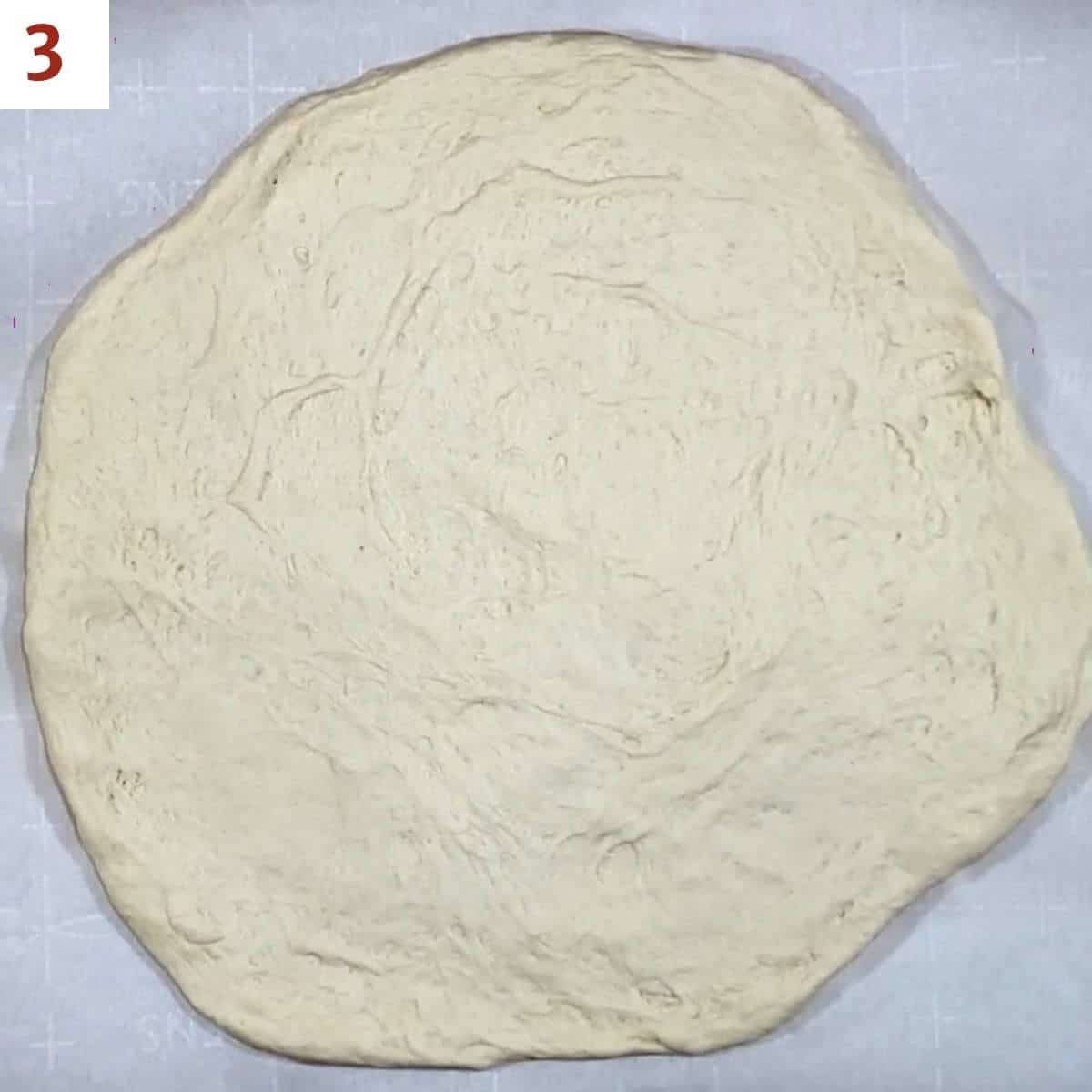
Step 3: Add the toppings
As I said in the beginning, pizza toppings are so personal.
In the photos I'm making a white pizza with garlic powder, a spritz of olive oil, fresh mozzerella cheese, and cooked slices of Beyond Sausage. I top everything with a generous amount of shredded cheese.
I like to fold over the edge and crimp it down (photo 4). It keeps any of the toppings from leaking out, and we like the thick edge to gnaw on. We call them pizza bones.
We're a funny bunch.

Step 4: Bake the pizza
The only tricky step is when you transfer the pizza to the oven. Use a pizza peel under the parchment paper, and carefully slide it onto the hot pizza stone.
Bake the pizza for 10 to 12 minutes or until the crust is light golden brown and the toppings are heated through (photo 5).

Step 5: Slice the pizza
Remove the pizza from the oven and transfer to a cutting board. Allow to cool for a couple of minutes, then use a pizza cutter to slice into six or eight slices (photo 6).
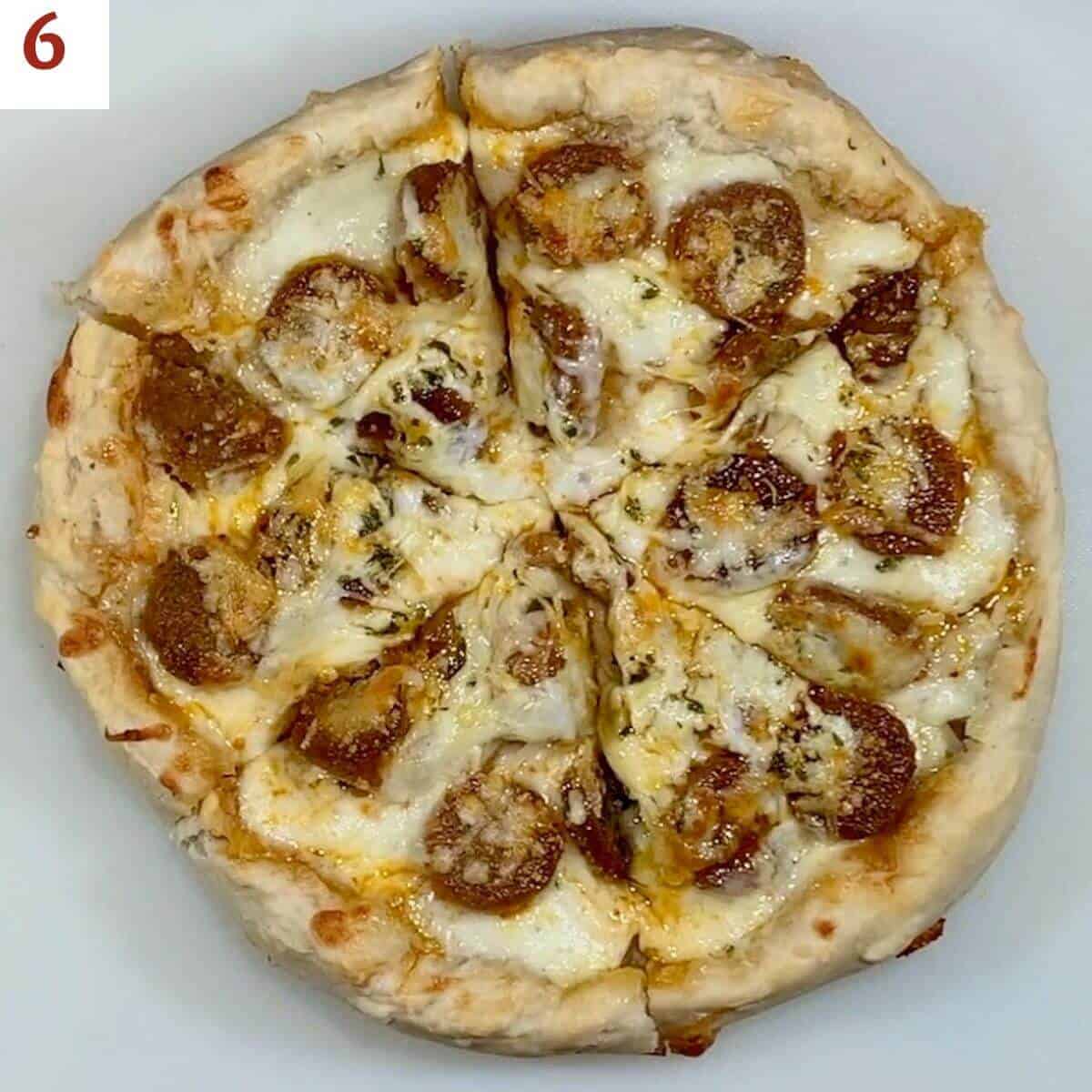
Make-ahead instructions
You can refrigerate the dough after the first rise overnight (up to 3 days) to develop more flavor. When you’re ready to proceed, allow the dough to come to room temperature for an hour or two continuing on.
For longer term storage, you can freeze the pizza dough after the first rise, sealed in an airtight bag, for up to 3 months.
Questions asked and answered
Here are some questions you might have...
Flour, especially higher protein flours (around 12% protein is good). The flour in the sourdough starter is fully hydrated, which can weigh down the dough and make it stodgy (I love that term. It means heavy, borrowed from The Great British Baking Show). You need that extra protein so the pizza dough maintains its gluten structure since it doesn't have a second rise after shaping.
Pizza flours (aka Type 00 flours) range from 9 to 15% protein content, so you'll want to be mindful if you choose one of those. The King Arthur Baking All-Purpose Flour has a protein content of 11.7% which works well (that's what I use with good results).
Also, since sourdough pizza dough has a 60% hydration level, the dough will be stiffer than a regular pizza dough. Flours with too high a protein level will be "thirsty" (that is, absorb more water), and will stiffen the dough even more. You want to strike a good balance so the dough will be workable.
You've got olive oil in the dough to help control the rise, but spraying the crust with it also helps to add flavor and creates a barrier between the dough and the toppings. This helps to prevent the dreaded soggy bottom!
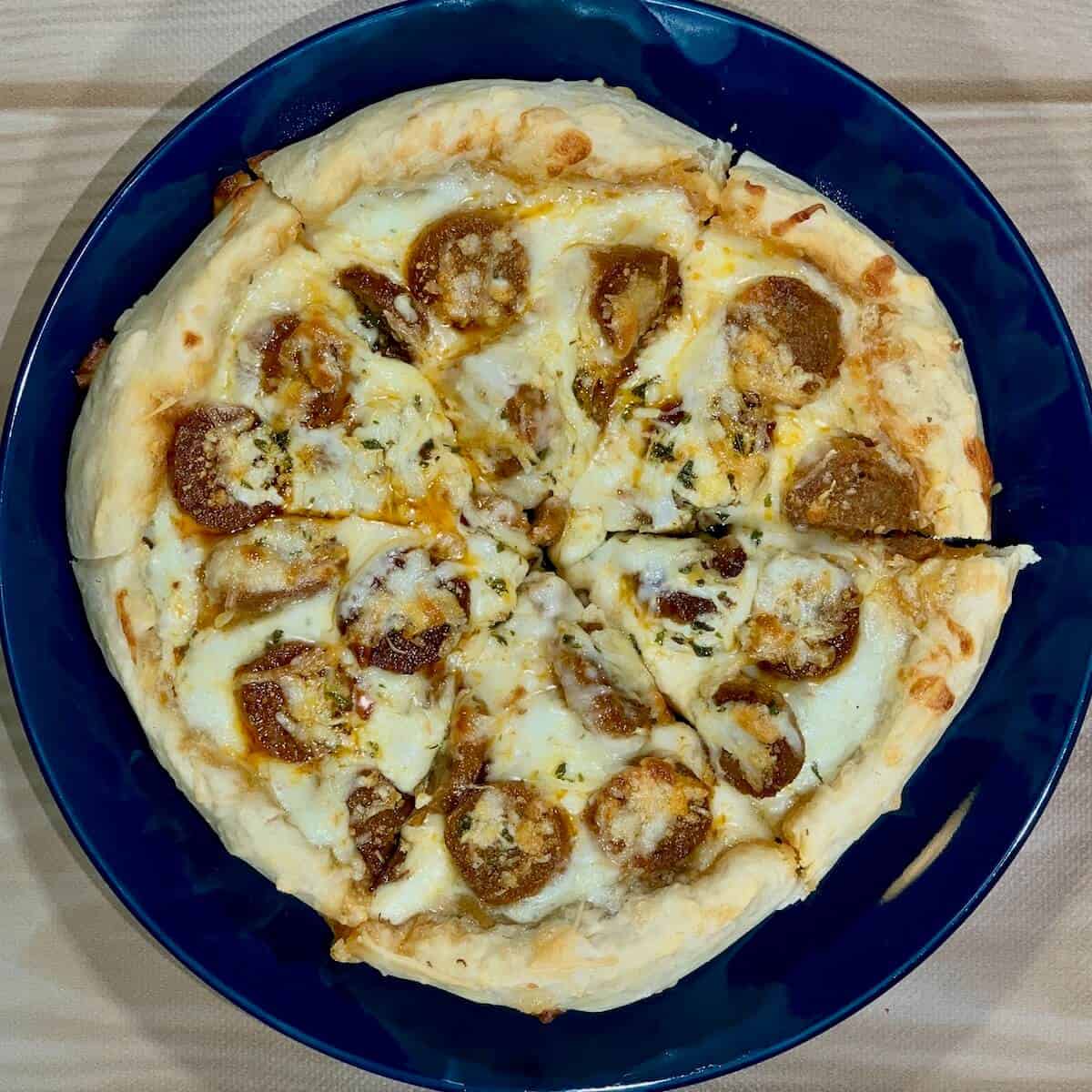
How to leave out the commercial yeast
If you don't want to use commercial yeast in this sourdough pizza crust recipe, replace the yeast with ½ cup (114 grams) of active, fed starter, and reduce the amount of flour by about ½ cup (57 grams) and water by about ¼ cup (57 grams). The rising time will be longer (about double) for both the first and second rises.
Turn your grill into an outdoor pizza oven
There are many options for baking your pizza. You can use your home oven (as I did above), or you can use an outdoor grill (either with or without a pizza stone). When you're really ready for the big leagues, it's time to look into getting a pizza oven.
While there are many types of pizza ovens you can choose, my favorite is this complete kit from KettlePizza that turns your gas or charcoal grill into an outdoor pizza oven! Along with the cover that holds in the heat (to get those high temps needed for a perfectly cooked crust), the kit comes with a pizza stone and wooden pizza peel.
There's a little learning curve to using it, so watching these videos really help hone in on what you need to do for success. Once my family started using this pizza oven, we really noticed how nicely crispy our pizza crust was. No soggy bottoms here!

A pizza crust with flavor
Move over store-bought pizza dough, we've got a more flavorful homemade pizza crust in town!
This sourdough pizza crust has a nice chewy texture, though not hard to tear with your teeth. And the flavor? A nice subtle tang that supports, but doesn't detract from, the toppings.
Did you know that you can use sourdough pizza dough for more than just pizza? Besides the aforementioned focaccia, you can use this same pizza dough recipe to make calzones or stromboli (essentially, stuffed pizzas). The method to make the dough is the same, just the shaping is different.
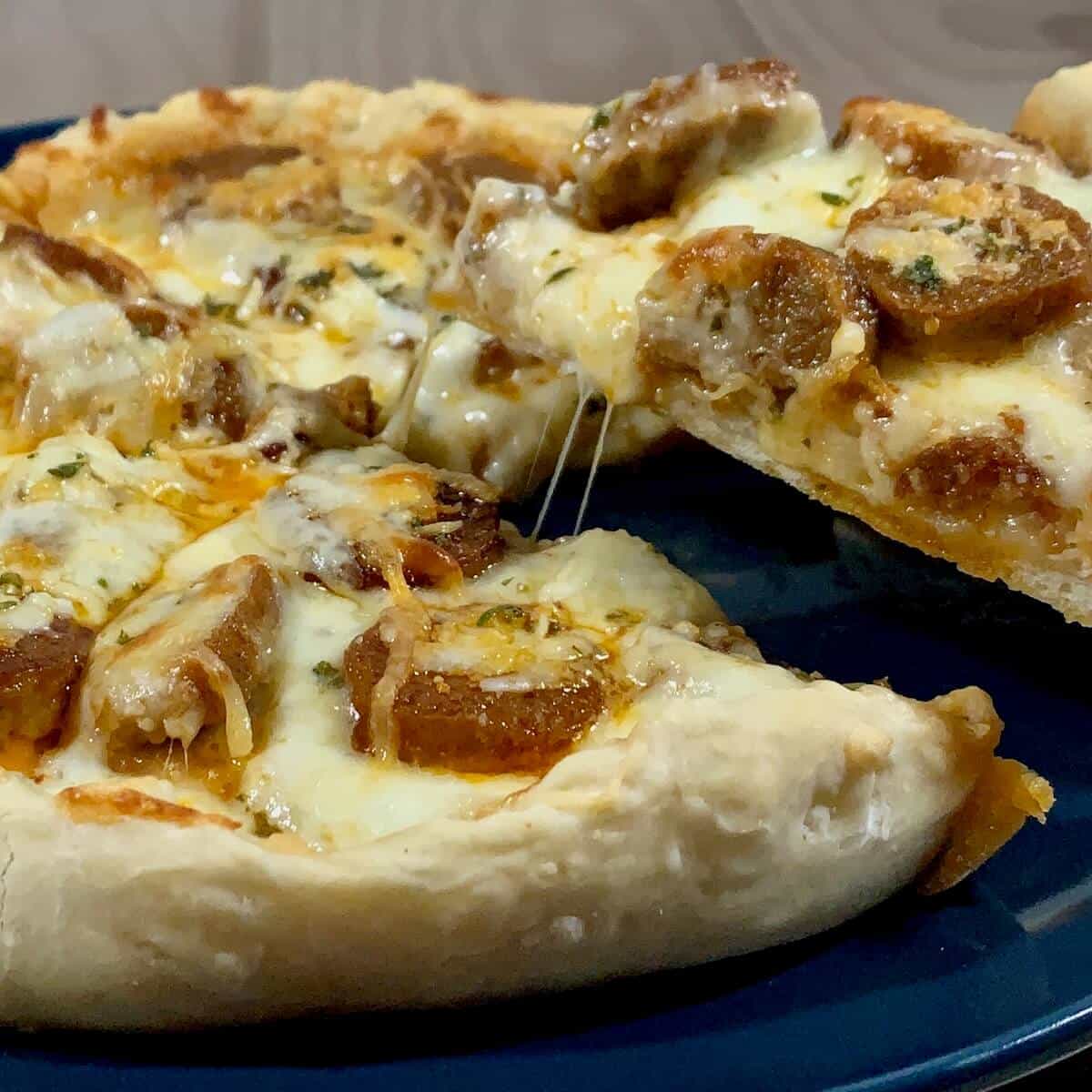
Making a sourdough pizza recipe is my favorite way of using my weekly sourdough starter discard. It's fast, it's easy, and I can make the dough that day or for later in the week.
The crust makes the pizza, and sourdough pizza dough makes a tangy crust you'll love. So skip the store bought stuff and make your own dough. It will be so much better, trust me. Give your pizza crust the flavor it deserves, and let Pizza Night begin!
More recipes featuring sourdough discard to try

Simple Sourdough Pizza Dough
Equipment
Ingredients
- 1 cup sourdough starter discard, unfed, at room temperature, see Recipe Notes
- 2¾ cups all-purpose flour, or more as needed, see Recipe Notes
- ½ to ⅔ cup water, warmed between 100°F to 110°F, see Recipe Notes
- 1 tablespoon extra virgin olive oil
- 1 tablespoon mixed herbs, chopped, like basil or oregano, optional
- 1 teaspoon kosher salt
- 1 teaspoon instant yeast, or rapid rise, see Recipe Notes
- pizza toppings, as desired
Instructions
- Make the dough: In the bowl of a stand mixer fitted with a dough hook, combine the flour, sourdough starter discard, water, extra virgin olive oil, mixed herbs (if using), salt, and yeast. Start with the lesser amount of water to account for the humidity of the day. If the dough is too dry, add in 1 tablespoon water as needed until the dough is the right consistency.
- Mix the dough on Low speed for about a minute, then turn up the speed to Medium-Low and knead until the dough is smooth, about 5 minutes.
- Shape the dough into a ball and place in a greased bowl. Cover the bowl with plastic wrap or a kitchen towel and put in a warm place to rest until the dough has doubled, about 2 to 3 hours. The oven with just the light on works well.
- Make the pizza: Place a baking stone in the oven, then preheat to 425 °F. For best results, let the oven heat for an additional 10 to 15 minutes after it says it's ready just to insure there are no hot spots.
- While the oven is heating, start to prepare the pizza. Lightly knead the dough on a piece of parchment paper, then start pressing out into a circle with your hands (you can use a pie pan roller to help). The size of the pizza will depend on how thick you like the pizza crust. I generally press it out to about ¼-inch thick and 10- to 12-inches in diameter.
- Top the pizza with your favorite toppings. For a finished edge, fold the crust over about 1-inch and crimp it down.
- Using a pizza peel, carefully transfer the pizza on the parchment paper to the hot baking stone.
- Bake the pizza for 10 to 12 minutes or until the crust is light golden brown and the toppings are heated through.
- Remove the pizza from the oven and transfer to a cutting board. Allow to cool for a couple of minutes, then use a pizza cutter to slice into six or eight slices. Serve immediately and enjoy!
- Make-ahead instructions: You can refrigerate the dough after the first rise overnight (up to 3 days) to develop more flavor. When you’re ready to proceed, allow the dough to come to room temperature for an hour or two continuing on. For longer term storage, you can freeze the pizza dough after the first rise, sealed in an airtight bag, for up to 3 months.




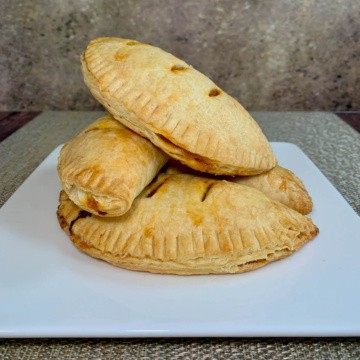



Comments
No Comments